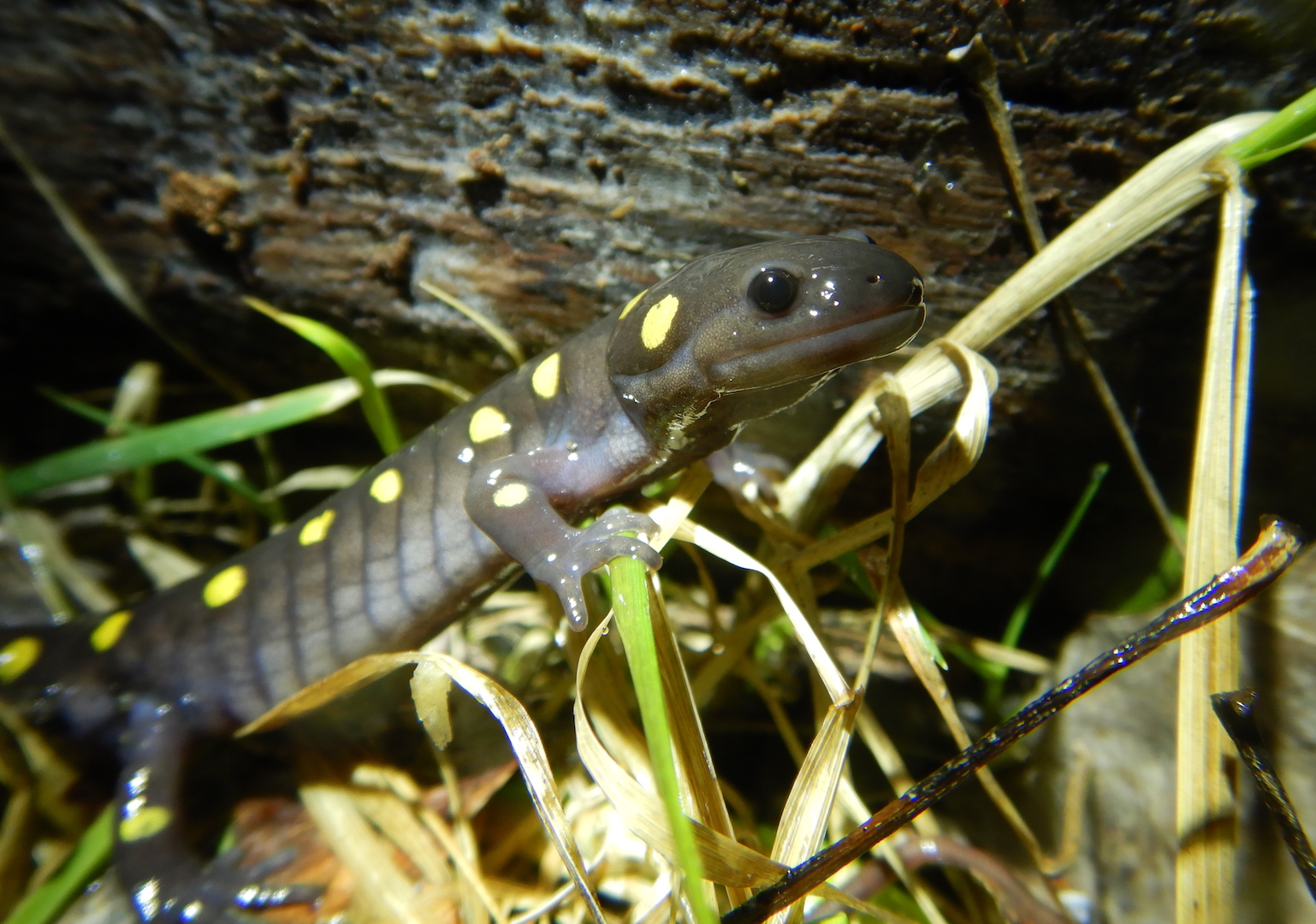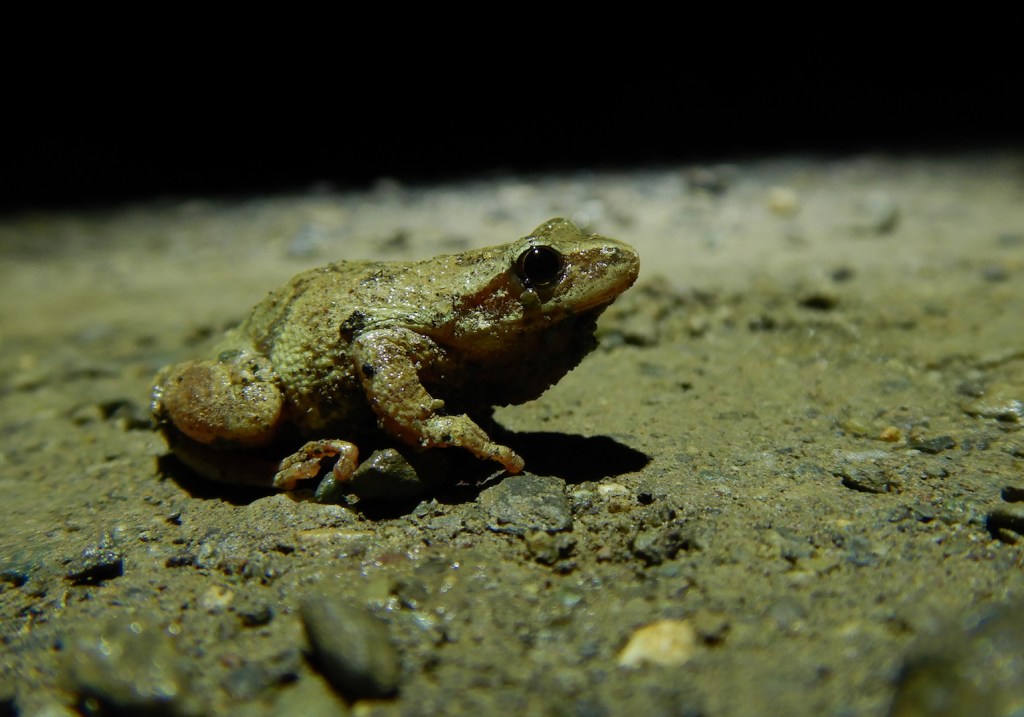In many ways winter is a glorious season. There’s nothing quite like the silence of the forest during a winter storm, when the landscape is remade under falling snow. During March, however, when snow has cloaked the land for months and summer seems a distant memory, I begin to dream of greener pastures, so to speak.
I’m not the only one who feels the pull of spring. For many animals, spring is not only a season of renewal but also one of frenzied business. Perhaps nothing symbolizes the end of winter in the northeast U.S. like the return of the amphibians.

Amphibians in the northeast U.S. lead relatively inconspicuous lives. During summer, I’m lucky to see a handful of spring peepers as I tromp through the forest or poke around my garden. Toads make their rounds, yet are camouflaged well enough to typically escape detection unless they hop. I might spot some bull and green frogs lurking on the edge of a pond, eyeing me warily, but I hear them calling far more often then I see them. Except for the boldly colored red efts or eastern newts, I typically don’t see salamanders unless I search the undersides of down logs, and I won’t see the more fossorial of salamanders, such as the spotted salamander, at all when they inhabit their burrows.
During winter, amphibians are even harder to come by. Tucked within the forest duff, wood frogs and spring peepers survive winter frozen like a popsicle (and I mean, actually frozen, not just cold). Adult newts remain hidden under the ice of their home pond. Spotted salamanders undergo their own form of hibernation in burrows they’ve appropriated from other animals.
Winter is often loath to end in Maine and the thaw usually progresses in spurts. In March or April, the warm days begin to outnumber the subfreezing. Meltwater and perhaps a cool drizzle percolates through crusty snow to the forest floor. Eventually, a storm front pushes through bringing overnight rain instead of snow. If the ground is mostly snow free and the rain coincides with temperatures above 40˚ F, I know it’s time to don my trusty yellow rain slicker and rubber boots for a walk in the dark. The mass amphibian migration nicknamed the Big Night has arrived.

Early spring this year brought unusually dry and warm weather in my region. The two plus feet of snowpack that lingered into mid March disappeared rapidly, but no rain came until April 10. That evening, right around 8 p.m., a light drizzle began to fall. Although I was unsure if it would be enough to initiate the amphibian migration, I only walked a few hundred yards along my road before I found out.
On the broken pavement, headed north to a small pond, sat a wood frog. Soon after, I found a spring peeper and then a gray tree frog. The amphibians were certainly on the move.



Activity along the next half mile of road was unsurprisingly sparse as it descended through forest without any close-by vernal pools or ponds. The next hillside, however, brought me through a true hotspot. I could hardly walk 50 feet without finding one or more spotted salamanders on the road.


While the frogs I had seen earlier live above ground during the active months, spotted salamanders live the majority of their lives underground or at least hidden under leaf litter, a lifestyle typical of the “mole salamanders” in the genus Ambystoma. They are conspicuous only during their brief breeding period in spring. Spotted salamanders return to reproduce in the same pond or vernal pool where they were spawned only to leave the water and return to their mole-like habits a few days later.
For me, a fellow who is increasingly interested in all critters small, the Big Night is one of the best evenings of the year. For the critters I seek, though, the Big Night can be one of the most dangerous experiences of their lives. Many do not survive their attempt to cross the road.
For wildlife, roads and motor vehicles are one of humanity’s most hazardous inventions. Although estimates vary widely, we probably kill hundreds of millions of vertebrate animals (and maybe even as many as one billion animals) on roads in the U.S. every year. This includes somewhere between 89 and 340 million birds. In 2015-2016, according to State Farm, 1.3 million collisions with large mammals cause enough vehicle damage for drivers to file insurance claims. Pennsylvania drivers led the charge with more than 133,000 wildlife-collision insurance claims. (I grew up and learned to drive in Pennsylvania and have unfortunately experienced more than one collision with deer. I’m not sure I have any family members in PA who haven’t struck deer in a car. Yay for the Keystone State.)
Since small animals like salamanders and frogs don’t cause vehicle damage, their road-caused mortality seems to be poorly quantified compared to large animals. A study from Massachusetts, though, found that motor vehicles are significant source of mortality for individual spotted salamanders and could lead to population extirpation if road mortality reached 20-30 percent of a population. Near prime breeding habitat, a Big Night migration can bring hundreds of amphibians onto roadways per hour. Afterward, when juvenile and adult amphibians disperse from their aquatic breeding habitat, road mortality can also be significant. However, dispersal from breeding ponds is more diffuse in time and space than the initial migration, and we know even less about road mortality during that phase of their lives.
Amphibians aren’t random users of the landscape. They seek out particular habitats. Spotted salamanders, for example, generally breed in the same water bodies where they were born. The collective migration to breeding ponds can funnel many individuals into a small area. This is where data gathering becomes an important conservation tool, especially if we are to lessen their risk of becoming road kill.
On April 10, I walked about three miles between 8 and 11 p.m. (the Big Night isn’t a fitness walk), but more than half of the salamanders I saw crossed the road within a single 100-yard stretch. On April 17, with just the barest spittle of rain falling, I walked the same road and saw no amphibians on it except within the same 100-yard section.

I’m fortunate to live along a quiet, rural road where traffic is light even on the busiest days. During my Big Night walks, I may only see three or four cars at most. Still, I find road kill salamanders. So, removing live amphibians from the roadway (in the direction they are headed, of course) gets them out of harms way.

Road hazards for wildlife is an issue that needs more attention from our policy makers and highway departments. To address it, we need, like so many things, systemic change. Road design must consider the safety of the most vulnerable—such as pedestrians, cyclists, and wildlife—before the convenience of motorists.
Individually, we can help by joining community science efforts such as the Big Night to document amphibian migrations and amphibian road mortality. We can also drive less, drive slower, and avoid driving at night when possible. Perhaps you might even be able to convince your town to temporally close roads during springtime amphibian migrations or build structures to guide amphibians under roads safely.
Amphibians bridge the aquatic and terrestrial worlds. They hail from an era in Earth’s history when vertebrates had yet to thoroughly colonize the continents. Their longevity as a taxonomic order (amphibians first appeared more than 350 million years ago) underscores that the strategy works. Yet, amphibians face increasingly dire challenges due to roads, disease, habitat loss, non-native species, the exotic wildlife trade, and climate change. Collectively, amphibians are the most threatened group of animals on the planet. Since we are the collective cause of these threats, then we owe it to amphibians to correct them.
The Big Night represents the transition between winter dormancy and the frenzied attempts of many amphibians to reproduce. Before documenting their migration across my road during the past two years, I had no idea that most spotted salamanders funneled to and crossed it along a single 100-yard long section. Searching for amphibians along roadways has helped me better understand their lives and their vulnerabilities in an increasingly human-dominated world.
Hahahaha: “One great thing about the Big Night is that it provides a valid excuse to handle frogs and salamanders.” Of course! And the little guy looks like s/he’s enjoying the ride, if we were to anthropomorphize. If not, it might be like Grumpy Cat saying “Just put me down.” 🙂
LikeLike
When I look at them, I see a complete nonplussed attitude staring back at me.
LikeLiked by 1 person
:-)))
LikeLike
Thank you for taking us along on your Big Night walking adventure Mike. I found your noted observations of interest and intrigue, as unbeknownst to me many, many decades ago when I was much younger growing up, I recall spring Big Nights of amphibians in my own local area. However, at that time in my life, my interests in nature and wildlife had not yet grasped the knowledge of how important all living creatures are to their ecosystems. Fortunately, several decades ago, I took the time to slow down in life and realize there were more important things in this world than material things to appreciate. I must have had an inkling that some day I’d fully appreciate nature and wildlife as i was never one to capture without soon releasing any insect or animal. I just wanted a closer up view of them. I use to hunt deer (only ever killed one with a gun and didn’t enjoy it), my second deer, yep, deer/auto collision. Otherwise my prey was rabbit, squirrels and pheasant for substance only, that was in my 20’s and 30’s, but the need to do so and my interest of taking life waned and I put away my shotgun and started carrying a camera into the woods with me. Now, forty years later I can be found shooting photos of birds in our native landscaped yard, frogs, toads and occasional salamander in our flower beds and water pool, insects visiting our flower beds and spending time just sitting and watching their behaviors as they go about their life. There was a time I considered working in the National Park Service but i took another career path in life, but I never lost the interests in nature and wildlife. That continued interest finds me fortunate to have found my way to Explore.org, definitely the Brooks bear cams. During your time there you presented the bears and the big picture of Katmai, (bears, salmon, ecosystem and history) in an easy to relate to, down to earth fashion. I love that you now are associated with Explore.org for following your blogs continues to be, fun, informative, knowledge expanding and sometimes even finds one, like myself, reflecting back on their own past experiences. Maybe even now understanding what I actually was participating in back then, without knowing it. Enjoyed and looking forward to your next blog.
LikeLike
Pingback: The Remarkable Hummingbird Tongue | Wandering at Large
Pingback: A Turd of a Time | Wandering at Large